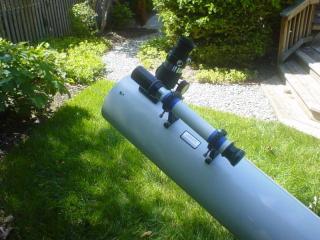 My oldest scope is an Edmund Palomar Jr (Pal Jr). It’s a 4.25 inch (108mm) Newtonian reflector on a German equatorial mount. It’s been in regular use ever since I got it in 1973. These days I use it primarily for solar observing using a Baader AstroSolar Safety Film aperture filter. I also use it to compare views with my Zhumell 10 inch (250mm) Dobsonian (Z-10) and to verify what a smaller aperture can show under washed-out skies.
My oldest scope is an Edmund Palomar Jr (Pal Jr). It’s a 4.25 inch (108mm) Newtonian reflector on a German equatorial mount. It’s been in regular use ever since I got it in 1973. These days I use it primarily for solar observing using a Baader AstroSolar Safety Film aperture filter. I also use it to compare views with my Zhumell 10 inch (250mm) Dobsonian (Z-10) and to verify what a smaller aperture can show under washed-out skies.
The optics on the Pal Jr are surprisingly good, consistently showing picture-perfect diffraction patterns. It gives great views of the planets and splits η Orionis whenever the seeing is decent. In dark skies, it’s shown me most of the Messier objects and plenty of NGCs. In washed-out skies it still gives good views of double stars, open clusters, the brighter globular clusters (without any hints of resolution), and the brighter nebulas (M27, M42, M57), but apart from M31 it is exceptionally hard to see any galaxies with it. I’ve made a point of including observations with the Pal Jr throughout Washed-out Astronomy to balance the Z-10 view with a smaller aperture view.
The most interesting thing about the Pal Jr is that it was hit by lightening some years ago….